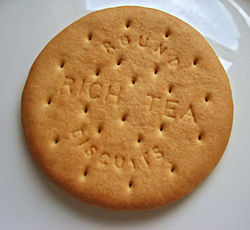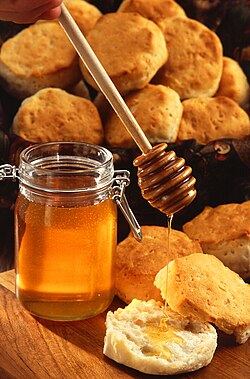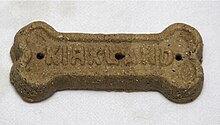Biscuit: Difference between revisions
IndieSinger (talk | contribs) mNo edit summary |
→Biscuits in North American usage: added {{fact}} tag |
||
| Line 74: | Line 74: | ||
American biscuits can be prepared for baking in several ways. The dough can be rolled out flat and cut into rounds, which expand when baked into flaky-layered cylinders. If extra liquid is added, the dough's texture changes to resemble stiff pancake batter so that small spoonfuls can be dropped into the baking sheet to produce "drop biscuits", which are more amorphous in texture and shape. Large drop biscuits, because of their size and rough exterior texture, are sometimes referred to as "cat head biscuits". Pre-shaped ready-to-bake biscuits can also be purchased in supermarkets, in the form of small refrigerated cylindrical segments of dough encased in a cardboard can. |
American biscuits can be prepared for baking in several ways. The dough can be rolled out flat and cut into rounds, which expand when baked into flaky-layered cylinders. If extra liquid is added, the dough's texture changes to resemble stiff pancake batter so that small spoonfuls can be dropped into the baking sheet to produce "drop biscuits", which are more amorphous in texture and shape. Large drop biscuits, because of their size and rough exterior texture, are sometimes referred to as "cat head biscuits". Pre-shaped ready-to-bake biscuits can also be purchased in supermarkets, in the form of small refrigerated cylindrical segments of dough encased in a cardboard can. |
||
Biscuits are ubiquitous throughout the U.S. and feature prominently in many [[fast food]] breakfast [[sandwich]]es. The biscuit sandwich burst onto the scene primarily through the [[Hardee's]] chain of restaurants as an answer to the [[McDonald's]] [[Egg McMuffin]]. Along with the traditional country ham, Hardee's added sausage, cheese, eggs, steak, and even chicken to the breakfast bread. Breakfast biscuits are much bigger than ham biscuits, most as big or bigger than a typical fast food hamburger. In addition, biscuits are commonly found as a side dish at [[fried chicken]] restaurants such as [[Kentucky Fried Chicken]], [[Church's Chicken]], [[Chicken Express]], [[Popeyes Chicken & Biscuits]], and [[Bojangles' Famous Chicken n' Biscuits]]. |
Biscuits are ubiquitous throughout the U.S. and feature prominently in many [[fast food]] breakfast [[sandwich]]es. The biscuit sandwich burst onto the scene primarily through the [[Hardee's]] chain of restaurants as an answer to the [[McDonald's]] [[Egg McMuffin]].{{fact}} Along with the traditional country ham, Hardee's added sausage, cheese, eggs, steak, and even chicken to the breakfast bread. Breakfast biscuits are much bigger than ham biscuits, most as big or bigger than a typical fast food hamburger. In addition, biscuits are commonly found as a side dish at [[fried chicken]] restaurants such as [[Kentucky Fried Chicken]], [[Church's Chicken]], [[Chicken Express]], [[Popeyes Chicken & Biscuits]], and [[Bojangles' Famous Chicken n' Biscuits]]. |
||
===Beaten biscuits=== |
===Beaten biscuits=== |
||
Revision as of 08:50, 31 October 2009

A biscuit (Template:Pron-en) is a kind of small, flat-baked bread product that is usually made with a chemical leavener such as baking powder. The exact meaning varies markedly in different parts of the world, and the meanings in British English and American English are quite distinct. The origin of the word "biscuit" is from Latin via Middle French and means "cooked twice,"[1] hence biscotti in Medieval Italian (similar to the German Zwieback, and still present in Dutch "beschuit"). In modern Italian usage the term biscotto is used to refer to any type of cookie, but not a savory cracker. Some of the original biscuits were British naval hard tack; such hard tack was made in the United States through the 19th century. Throughout most of the world, the term biscuit still means a hard, crisp, brittle bread, except in the United States and Canada, where it now denotes a softer bread product baked only once. The word 'biscuit' transliterated into Russian or Ukrainian has come to mean 'sponge cake'.
Biscuits in British usage

In British English, a biscuit is a hard baked sweet or savoury product like a small, flat cake, which in North America may be called a "cookie" or "cracker". The term biscuit also applies to sandwich-type biscuits, where a layer of 'cream' or icing is sandwiched between two biscuits. In the UK, "cookie" is usually only used in specific terms such as "chocolate chip cookie" or to refer to larger, softer American style biscuits. Referring to the Sesame Street character the Cookie Monster, British author Chris Roberts quipped that he prefers the word "cookies" over "biscuits," "as a character called Biscuit Monster would never have worked."[2]
Sweet biscuits are commonly eaten as a snack and are generally made with wheat flour or oats and sweetened with sugar or honey. Varieties may contain chocolate, fruit, jam, nuts or even be used to sandwich other fillings. There is usually a dedicated section for sweet biscuits in most UK supermarkets. In Britain, the digestive biscuit and rich tea have a strong cultural identity as the traditional accompaniment to a cup of tea, and are regularly eaten as such. Many tea drinkers "dunk" their biscuits in tea, allowing them to absorb liquid and soften slightly before consumption.
Savoury biscuits or crackers (such as cream crackers, water biscuits, oatcakes or crisp breads) are usually plainer and commonly eaten with cheese following a meal. There is also a large variety of savoury biscuits that contain additional ingredients for flavour or texture, such as poppy seeds, onion or onion seeds, cheese (such as cheese melts) and olives. Savoury biscuits also usually have a dedicated section in most UK supermarkets, often in the same aisle as sweet biscuits. The exception to savoury biscuits is the sweetmeal digestive known as a "Hovis biscuit," which, although slightly sweet, is still classified as a cheese biscuit.
Generally, Australians, South Africans, New Zealanders, Indians and the Irish use the British meaning of "biscuit" (colloquially referred to as a bickie) for the sweet biscuit. Two famous Australasian biscuit varieties are the ANZAC biscuit and the Tim Tam. This sense is at the root of the name of the United States' most prominent maker of cookies and crackers, the National Biscuit Company, now called Nabisco.
Biscuits in North American usage

In American English, a "biscuit" is a small bread made with baking powder or baking soda as a leavening agent rather than yeast (although a type of biscuit called an 'angel biscuit' contains yeast as well, as do those made with a sourdough starter). This roughly corresponds to a "scone" in British English usage. Biscuits, soda breads, and corn bread, among others, are often referred to collectively as "quick breads" to indicate that they do not need time to rise before baking.[3][4]
Biscuits have a firm browned crust and a soft interior, similar to British scones or the bannock from the Shetland Isles. A sweet biscuit layered or topped with fruit (typically strawberries), juice-based syrup, and cream is called shortcake. In Canada, both sweet and savory are referred to as "biscuits," "baking powder biscuits," or "tea biscuits," although "scone" is also starting to be used.[citation needed]
Biscuits are a common feature of Southern U.S. cuisine and are often made with buttermilk. They are traditionally served as a side dish with a meal. As a breakfast item they are often eaten with butter and a sweet condiment such as molasses, light sugarcane syrup, sorghum syrup, honey, or fruit jam or jelly. With other meals they are usually eaten with butter or gravy instead of sweet condiments. However, biscuits and gravy (biscuits covered in country gravy) are usually served for breakfast, sometimes as the main course.
A common variation on basic biscuits is "cheese biscuits", made by adding grated Cheddar or American cheese to the basic recipe.[5]

American biscuits can be prepared for baking in several ways. The dough can be rolled out flat and cut into rounds, which expand when baked into flaky-layered cylinders. If extra liquid is added, the dough's texture changes to resemble stiff pancake batter so that small spoonfuls can be dropped into the baking sheet to produce "drop biscuits", which are more amorphous in texture and shape. Large drop biscuits, because of their size and rough exterior texture, are sometimes referred to as "cat head biscuits". Pre-shaped ready-to-bake biscuits can also be purchased in supermarkets, in the form of small refrigerated cylindrical segments of dough encased in a cardboard can.
Biscuits are ubiquitous throughout the U.S. and feature prominently in many fast food breakfast sandwiches. The biscuit sandwich burst onto the scene primarily through the Hardee's chain of restaurants as an answer to the McDonald's Egg McMuffin.[citation needed] Along with the traditional country ham, Hardee's added sausage, cheese, eggs, steak, and even chicken to the breakfast bread. Breakfast biscuits are much bigger than ham biscuits, most as big or bigger than a typical fast food hamburger. In addition, biscuits are commonly found as a side dish at fried chicken restaurants such as Kentucky Fried Chicken, Church's Chicken, Chicken Express, Popeyes Chicken & Biscuits, and Bojangles' Famous Chicken n' Biscuits.
Beaten biscuits

Beaten biscuits are a "Bluegrass" Southern food from the United States. They date from the 1800s. They differ from a regular biscuit in that they are more like hardtack, in New England they are called "sea biscuits"[6] and they were staples aboard whaling ships.[7]
The dough was originally made from flour, salt, sugar, lard, and cold water, and beaten with a hard object or against a hard surface. It is pricked with a fork prior to baking and cut smaller than a regular biscuit.[8]
How long the biscuits are beaten varies from one recipe to the next, from "at least 15 minutes"[6] to "30 to 45 minutes."[8] The beating these biscuits undergo is severe: they are banged with a "rolling pin, hammer, or side of an axe"[6]; or they are "pounded with a blunt instrument...[even] a tire iron will do...Granny used to beat 'em with a musket";[9] one book "instructs the cook to 'use boys to do it'"--that is, beat the biscuits vigorously "at least 200 times."[10] Besides ensuring the proper texture for the biscuit, "this beating also serves to vent the cook's weekly accumulation of pent-up frustrations."[9]
These are the biscuits traditionally used in "ham biscuits," also known as "hog cakes," a traditional Southern canapé, which are simply tiny sandwiches of these bite-sized biscuits sliced horizontally, spread with butter, jelly, mustard, filled with pieces of country ham, or sopped up with gravy or syrup.[9][10] They are sometimes considered "Sunday biscuits" and can be stored for several months in an airtight container.[9] Beaten biscuits were once so popular that special machines, called biscuits brakes, were manufactured to knead the dough in home kitchens.[9] A biscuit brake typically consists of a pair of steel rollers geared together and operated by a crank, mounted on a small table with a marble top and cast iron legs.
Dog biscuits

Dog biscuits are a dietary supplement to dog food, similar to human snack food. They tend to be hard and dry. Dog biscuits may be sold in a flat bone-shape (as might be made using a bone-shaped cookie cutter). Some manufacturers claim the dry and hard biscuit texture helps clean the dog's teeth, promoting oral health.
Standardization of the products
In 2006, a revised Codex Alimentarius standard was published, which targets the quality of the products related to their consumptions by infants and children.[11]
See also
References
- ^ "Biscuit". Oxford English Dictionary. Oxford University Press. 2009.
{{cite encyclopedia}}:|access-date=requires|url=(help) - ^ Roberts, Chris (2006). Heavy Words Lightly Thrown: The Reason Behind Rhyme. Thorndike. ISBN 0-7862-8517-6.
{{cite book}}: Cite has empty unknown parameter:|coauthors=(help) - ^ Irma S. Rombauer (2006). The Joy of Cooking. New York: Scribner. p. 627. ISBN 9780743246262.
{{cite book}}: Unknown parameter|coauthors=ignored (|author=suggested) (help) - ^ Ojakangas, Beatrice A. (2003). Quick Breads. U of Minnesota P. p. 1. ISBN 9780816642281.
{{cite book}}: Unknown parameter|coauthors=ignored (|author=suggested) (help) - ^ Better Home's and Garden Cookbook
- ^ a b c Villas, James (2004). Biscuit bliss: 101 foolproof recipes for fresh and fluffy biscuits in just minutes. Harvard Common Press. p. 14. ISBN 9781558322233.
{{cite book}}: Cite has empty unknown parameter:|coauthors=(help) - ^ Biscuit bliss By James Villas page 14
- ^ a b "Beaten Biscuit". Encyclopedia. Food Network. Retrieved 2009-04-27.
{{cite web}}: Cite has empty unknown parameter:|coauthors=(help) - ^ a b c d e Alvey, R. Gerald (1992). Kentucky Bluegrass country. UP of Mississippi. p. 261. ISBN 9780878055449.
{{cite book}}: Cite has empty unknown parameter:|coauthors=(help) - ^ a b Claiborne, Craig (2007). Craig Claiborne's Southern Cooking. Athens: U of Georgia P. p. 254. ISBN 9780820329925.
{{cite book}}: Unknown parameter|coauthors=ignored (|author=suggested) (help) - ^ Codex Alimentarius. "Cocex Standard for Processed Cereal-based Foods for Infants and Young Children" (PDF). Retrieved 1 June.
{{cite web}}: Check date values in:|accessdate=(help); Cite has empty unknown parameter:|coauthors=(help); Unknown parameter|accessyear=ignored (|access-date=suggested) (help)
